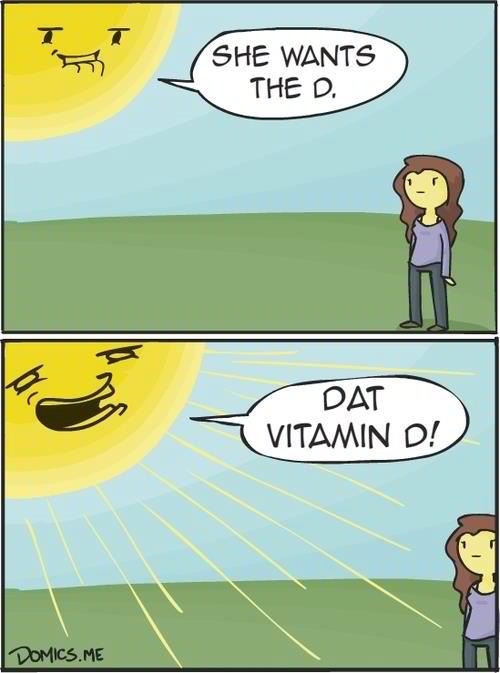One of the trendiest things in medicine today, if the medical world can have a ‘trendy’ thing, is vitamin D. Its totally the new(ish) buzz. Vitamin D has a whole list of functions throughout our bodies, but mostly is responsible for calcium absorption in our intestines and kidneys. The reason why this vitamin has become so exciting recently is that research is showing that it might have the ability to lower your cancer risk and reduce the chance of complications or death from cancer.
Lets look at what happens when we are vitamin D deficient: First, your intestines have a hard time absorbing calcium and phosphorous –> this forces your body to suck the calcium out of your skeleton –> this causes small areas of bone weakness and generally decreases the bone mineral density (weaker bones) –> this leads to osteoporosis in adults and muscle weakness in children.
How does this relate to cancer? Cancer will often spread from its point of origin to the bone. If your bones are stronger then the cancer has a harder time spreading there.
The major source of vitamin D has always been exposure of skin to sunlight. When it is produced in the skin, vitamin D can last at least twice as long in the blood compared to when you eat your D. Therefor, the main cause of vitamin D deficiency is not getting enough sun. Here are a few factors that can reduce your skins production of D:
- darker skin (you’ll need 3-5 times more sun exposure than lighter skin),
- aging,
- topical sunscreen (SPF 30 reduces vitamin D synthesis by more than 95%),
- obesity (the fat holds the vitamin hostage).
In the absence of sun exposure it is difficult, if not impossible, to obtain an adequate amount of vitamin D from dietary sources without supplementation. But we also have to be careful about the risk of skin cancer from too much sun. The current recommendation is to spend 10-15 minutes in the sun, without sunscreen, three times a week. But its not a bad idea to eat some vitamin D or take a vitamin D supplement.
Here are some dietary sources of vitamin D:
- cod liver oil (400-1,000 IU/tsp)
- salmon, fresh (600-1,000 IU/ 3.5oz)
- salmon, other (100-600 IU/ 3.5oz)
- shitake mushrooms, dried (1,600 IU/ 3.5 oz)
- fortified milk, OJ, infant formula, yogurt (100 IU/ 8oz)
Here is the recommended daily intake of vitamin D, from all sources (food, sun, supplements):
- age 0-1 year: 400-1,000 IU
- age 1-18 years: 600-1,000 IU
- age 19 on: 1,500-2,000 IU
Numerous studies have suggested that adequate blood vitamin D levels (above 30) may have additional health benefits in reducing autoimmune diseases, type 2 diabetes, cardiovascular disease, and infectious diseases. This doesn’t mean that the more vitamin D you eat, the healthier you will be. You can, for example, overdose on vitamin D and end up with calcium deposits in your blood. And some people might actually have an increased chance of some types of cancer when they have too much vitamin D.
In summary: vitamin D is made when your skin is exposed to sunlight and, less efficiently, can also be eaten or taken as a supplement. Vitamin D is used by the body to help keep your bones healthy; so a deficiency can lead to osteoporosis. Vitamin D is also proving to be an important factor in preventing or limiting cancer. Personally, I am now taking vitamin D supplements and sitting in the sun for a few extra minutes each week, arms and legs exposed. But I’m not going to stop putting sunscreen on my face and neck because I’m vain and want to look young for as long as possible.













